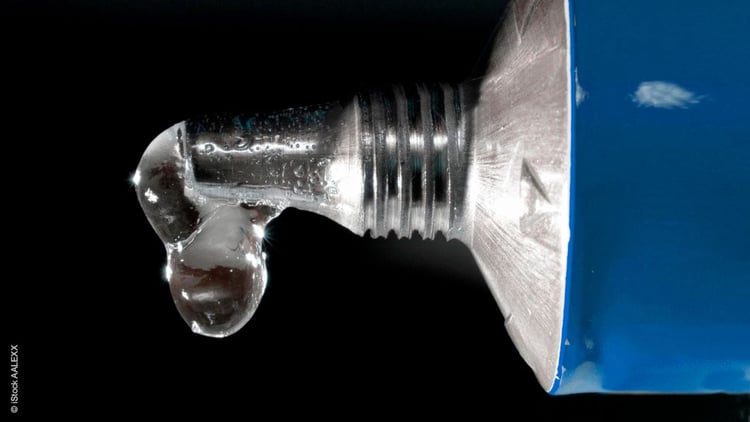
It is impossible to imagine our lives without adhesives. Due to the latest developments in this field, many things are no longer screwed or plugged in, but permanently bonded. This saves time, material and enables previously unknown applications and designs. In order to offer the market individual adhesives, the solvents required for the adhesives must also have special properties. Here you can get an overview of paraffinic solvents for your special adhesives.
Not all adhesives need solvents
Classic adhesives are familiar to us, such as white glue for woodworking, the all-purpose glue with its typical smell or water-based handicraft adhesives. In addition, there are also solvent-free adhesives such as superglue or hot melt for hobby applications.
The variety of adhesives used in technical or industrial applications are almost unlimited. The individual material requirements of the materials to be bonded play a major role and special solutions are often required.
The most commonly used solvents are water, followed by oxygen-containing solvents. Hotmelt adhesives do not require any solvents at all.
The two best-known products are the hot-melt adhesive and the superglue. Hot-melt adhesives consist of polyethylene, polyvinyl acetate, waxes and other additives. They only stick as long as they are hot and soft. Industrially, they are often used in furniture construction. The well-known superglue is a molecule that polymerises within a few seconds under the influence of e.g. air moisture and produces a strong but also brittle bond. It is therefore mostly offered for household use, as the layer only hardens completely at low thickness and is not very resistant to any mechanical stress.
Other reactive adhesives are two component (2-C) adhesives. They usually consist of an unsaturated polyester or an epoxy resin mixed with a hardener. The compound cures within a short time and shows a certain flexibility and high load-bearing capacity.
In the building sector, where plastics are often used, adhesive formulations based on hydrocarbons are frequently found, but they are also found in many other industrial and Do-It-Yourself (DIY) areas.
The particular role of hydrocarbons in adhesive formulations
Often finished adhesives contain not only one solvent but several to bring the different components of the adhesive into solution with each other.
Paraffinic Solvents play a special role in adhesive formulations. Their solvency power is lower than that of aromatics or oxygen-containing solvents, but this can be offset by a change in the formulation components. Boiling cuts, so-called petroleum ethers or special petrol can be used. These have a wide but defined boiling range and are free of harmful aromatics.
The internal composition is variable and can vary from manufacturer to manufacturer. If more precision is required, the formulator uses high-purity paraffins. These have a narrowly defined boiling point and therefore enable improved evaporation properties and a generally higher and more controllable performance of the adhesive.
Depending on the application, these can be linear n-paraffins such as n-heptane or n-nonane. Iso-paraffins such as iso-octane have slightly different solution properties. Both types of molecule are found in mixtures in the specialty gasolines.
Even better general solution properties are provided by the so-called cycloparaffins or naphthenes. These are ring-shaped molecules that are often the product of the hydrogenation of aromatics such as benzene or toluene. Cyclohexane is a popular naphthenic solvent for adhesives, and the slightly higher boiling methylcyclohexane is equally suitable.
Excursus: "Bonding without adhesives”Pure paraffins have the property of not attacking most plastics. Their solubility is too low to dissolve the polymer. However, in many plastics they act as a temporary plasticizer. Companies use this property to bond plastics, especially pipes. This is because the surface of many plastics is repellent to the adhesive: no permanent bond would be formed. If, for example, a pipe is briefly swelling in a paraffinic solvent, the structure becomes softer but does not lose its shape. It is similar to heating the piece of pipe. If the pipes to be joined are pushed into each other and the paraffin evaporates, the pipe shrinks back into its old shape and bonds permanently. |
Paraffinic solvents and their application
The intended use of the adhesive determines the performance profile of the solvent. Often a special petrol (i.e. a boiling cut of raw petrol or naphtha) is sufficient to achieve a good result. Special applications, however, require a precise performance of the adhesive, which can only be achieved by a pure paraffin such as cyclohexane, n-heptane or iso-octane.
- Spray adhesives contain large amounts of highly volatile solvents. As they are easily evaporated, they are generally only used for small areas or directly under fume extraction. Spray adhesives usually contain, in addition to other solvents, special benzenes or light paraffins such as iso-hexane, n-heptane or octane.
- Rubber/ ethylene-propylene-diene rubber (EPDM)/plastic adhesives: These adhesives should not attack, swell or otherwise damage the plastic to be bonded. Polystyrene foam with its fine structure is particularly affected here. The adhesives are either solvent-free or exploit the ideal properties of special petrol and pure paraffins.
- Universal adhesives for industry, construction and handicrafts contain a variety of different solvents, mostly mixtures of oxygenated and paraffinic components.
- Foam and foam padding adhesives take into account the fine structure of the material. Solvents that are too aggressive or swell cause the material to sink in or be completely destroyed. Pure paraffins ensure that the adhesive behaves precisely and does not attack the material.
- Adhesion primer or primer are treatments that prepare a substrate for bonding. Some plastics such as polyethylene or polypropylene cannot be bonded without prior treatment. Again, it is important that the solvent does not cause the plastic to swell, warp or become brittle. Primers containspecial benzenes and pure paraffins as formulation components.
In order to achieve the perfect composition for the most diverse end applications, Haltermann Carless offers different pure paraffins and different boiling ranges as solvents for adhesive formulations.
Read more about the product properties of our solvents for your special adhesives here!
Conclusion
Adhesives join together everyday objects as well as highly complicated special products and are indispensable in both everyday use and industry. This diversity requires countless individual adhesive formulations as well as suitable solvents. Finding the perfect solvent for a particular special adhesive is becoming more and more of a challenge. Let us provide you with consulting without obligation!





















